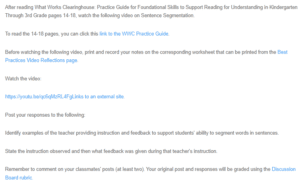Peer Responses – Sentence Segmentation
Response 1
Hello,
I have read your reflection post and would love to congratulate you for a thoughtful discussion. I agree that the video has crucial information that can help instructors guide students in segmenting words into sentences. This can be achieved when students repeat reading sentences given to them to master how every word should correctly be pronounced, hence improving their fluency in reading (Institute of Education Sciences, 2016). However, I would love to add that other than the repetition strategy, another essential skill to consider in the future is swapping letter sounds in words, as seen in the video. For example, the teacher guiding learners to pronounce words such as “dog” and “cat” could change the first sound of every phrase to gauge the sound understanding of the learners.
References
Institute of Education Sciences. (2016, September 19). Video 10: Sentence segmentation [Video]. YouTube. https://www.youtube.com/watch?v=qc6qMzRL4Fg
Response 2
Hello,
Thank you for a thoughtful reflection post. The first thing I noted in your post is that when starting the class by introducing the learners to the topic segmenting sentences, the teacher helped her learners understand what they expected during the lesson. I agree with your point of view that stating instruction before beginning the class helps to let the learners understand what is expected of them. For instance, the teacher explains to students that they will say the sentence, count words, and map it out (Honig et al., 2018). However, one additional thing to incorporate that is vivid in the video is that segmenting sentence lessons should include a lot of practice using the resources or materials.
References
Honig, B., Diamond, L., & Gutlohn, L. (2018). Teaching reading sourcebook (3rd ed.). Arena Press/Academic Therapy Publications.
Response 3
Hi,
I read your discussion and would love to congratulate you for a good conversation. Indeed, manipulatives are important physical teaching sources because they help improve student engagement. For example, when the teacher uses blocks, puzzles, and markers, it helps to improve learners’ attention during the lesson (Institute of Education Sciences, 2016). Additionally, I agree with your point of view that repeating words is a crucial skill in teaching sentence segmentation to young children. It is a measure of children’s language skills. For instance, when a teacher uses strings of words repetitively, children learn the combinations that work best for the meaning they are trying to convey.
References
Institute of Education Sciences. (2016, September 19). Video 10: Sentence segmentation [Video]. YouTube. https://www.youtube.com/watch?v=qc6qMzRL4Fg
ORDER A PLAGIARISM-FREE PAPER HERE
We’ll write everything from scratch
Question

Response – Sentence Segmentation
After reading What Works Clearinghouse: Practice Guide for Foundational Skills to Support Reading for Understanding in Kindergarten Through 3rd Grade pages 14-18, watch the following video on Sentence Segmentation.
To read the 14-18 pages, you can click this link to the WWC Practice Guide.
Before watching the following video, print and record your notes on the corresponding worksheet that can be printed from the Best Practices Video Reflections page.
Watch the video:
https://youtu.be/qc6qMzRL4FgLinks to an external site.
Post your responses to the following:
Identify examples of the teacher providing instruction and feedback to support students’ ability to segment words in sentences.
State the instruction observed and then what feedback was given during that teacher’s instruction.
Remember to comment on your classmates’ posts (at least two). Your original post and responses will be graded using the Discussion Board rubric.


